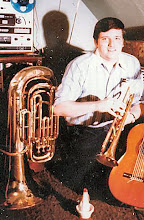
Side 1
1. Licorice Stick
2. Young Maiden's Prayer
3. Gravy Waltz
4. Fountain Blue
5. Tippin In
6. Estrellita
Side 2
1. Hello Dolly
2. Maria Elena
3. Clairnet Strip
4. Born To Lose
5. The Honey Wind Blows
6. I Love You So Much It Hurts
Liner Notes:
LICORICE STICK PETE FOUNTAIN
Charles Bud Dant And His Orchestra
All black and silver, the clarinet wears the air of an aristocrat amongst its usual orchestral companions of contorted brass and bulbous woodwork. But its severe, clean lines are functional, too, as befit an instrument of breeding and long history. The ancient Egyptians, for example, are believed to have used a simple model made of cane. Another predecessor was the French chalumeau, and, when keys were added to this at the end of the seventeenth century, the instrument materialized which Mozart so esteemed and which we know today in slightly modified form.
The clarinet has been a kind of musical magic wand throughout the story of twentieth-century music, especially in the hands of the wizards from Pete Fountain's hometown, New Orleans. Perhaps it all derives from the French influence in that city, from a heritage left by some master of the chalumeau, but the fact is that in one way or another the New Orleans clarinet style has been an all-pervasive influence in jazz and popular music ever since the importance of the instrument's voice was established by the marching bands and the earliest jazz groups. George Gershwin recognized it in the position he gave the instrument in "Rhapsody In Blue," and Benny Goodman, Barney Bigard and Artie Shaw re-emphasized it in the triumphant big bands of the Swing Era.
Musical instruments are subject to fashion, of course, and one year there is a vogue for the trumpet, the next for piano, or tenor saxophone, or guitar, or flute, or organ, but the clarinet survives because it has a unique sound which delights the human ear, and today it is probably played by more musicians, amateur and professional, than ever before.
It isn't easy to play, for the make-up of the clarinet is such that it is like two instruments, each played in a different register. The lower register, still known as the chalumeau, yields a warm, mellow sound, whereas the upper register makes possible those shrilling, incisive high notes which are so exciting in jazz. Because the upper register is harder to play, many musicians like to display their skill in it with exhibitionism that is often detrimental to musical content.
Pete Fountain doesn't make that mistake. In this album, he is particularly concerned with the relaxed, fluent expression of melody and his instrument's tonal qualities. The big, warm tone, flowing phrases and expressive vibrato are mostly in the familiar New Orleans tradition, but the instrumentation of the accompanying groups is decidedly unusual. Only on Born To Lose, in fact, is he heard in his normal context of rhythm section and vibes. For Gravy Waltz, eight fiddles, a trumpet and trombone are added. On the other ten numbers he is accompanied by some of Nashville's most versatile musicians and by a vocal group, the Jordanaires.
The program is knowingly varied, all the way from the old Erskine Hawkins' hit, Tippin' In, to Louis Armstrong's big one of 1964, Hello, Dolly! And there are new ones by Pete himself, too. His Clarinet Strip is a light-hearted performance and the Jordanaires enter into its spirit with enthusiasm, while Fountain Blue, in complete contrast, is a pensive ballad which features Millie Kirkham's pretty voice and the leader's lyrical horn. In short, a dozen clarinet-colored numbers are here cooked and served to suit as many moods.
STANLEY DANCE




No comments:
Post a Comment